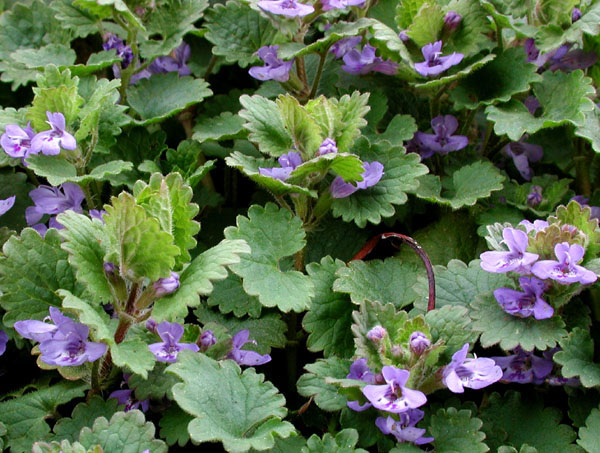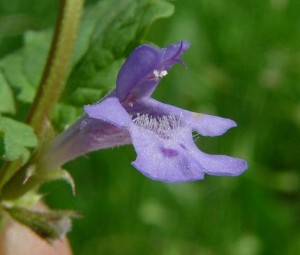Most of the time when someone mentions Ground Ivy the comment usually is something like “How do I get rid of the damned stuff?” Here at ETW we have have the solution.
Ground Ivy, Glechoma hederacea, is a creeping perennial that roots at the nodes and smells similar to mint when crushed or mowed. It’s a prime weed of turfgrass and landscapes. If you like well-behaved Engish type gardens then Ground Ivy will drive you insane because it may be small but it’s the Botanical Bull in the China Shop. It doesn’t take over, it takes command. While there are no look alikes — if you look closely enough — there are four species which from some distance might be mistaken for Ground Ivy. It is often misidentified as a Common Mallow (Malva neglecta), but the square stem of Ground Ivy distinguishes it from the Common Mallow which has a round stem. Henbit (Lamium amplexicaule), Purple Deadnettle (Lamium purpureum) and Persian Speedwell (Veronica persica) are somewhat similar in appearance to Ground Ivy, but none of them have creeping stems that root at the nodes. Of these four all but the Persian Speedwell are edible.
Ground Ivy, once known as Nepeta glechoma and Nepeta hederacea in the Catnip genus, is a native of Europe and southern Asia. It was introduced into North America by 1672, probably earlier, for medicinal uses. Gound Ivy moved west and was naturalized in Indiana by 1856 and Colorado by 1906. How and exactly when it was distributed is not known. While it concentrates in the deciduous and riparian forests of the Northeast and around the Great Lakes it is now found throughout North American except for the desert southwest (New Mexico, Arizona, Nevada) and the three top tier northwest Canadian Providences (the Yukon, Northwest Territories, Nunavut.) It also surprisingly missing on the east end of the continent from the islands of Saint Pierre and Miquelon.
Don’t know where Saint Pierre and Miquelon are? This is your lucky geographic day: The islands are situated at the entrance of Fortune Bay off the southern coast of Newfoundland. They are not part of Canada but still part of France, a leftover toehold in the New World from colonial days. Residents are French citizens and vote in French election though the home county is more than 4,000 miles to the east. It was from these islands that a large amount of Canadian whisky was smuggled into the United States during prohibition. Makes you think they should have called it French Whisky, or at least French Canadian Whisky.
Though you may think Ground Ivy’s botanical name has some Scottish influence it’s totally Mediterranean…well, almost. Glechoma is latinized Greek, or in this case very bastardized Greek for pennyroyal. The Greek word is Βλήχων, said VLEE-kon, yes, with a V. How that got mangled into gleh-KOH then gleh-KOH-ma is any linguistic guess. This also why the genus spelled Glechoma and Glecoma because there is no agreement on how to translate the Greek X into Dead Latin or English. The X is close, though, to the CH as in a Scottish “loch” but not as hard. Hederacea (head-er-ah-SEE-uh) is Dead Latin for “like ivy” read creeping. When all put together it kinds of means Pennyroyal Ivy. Common names include Alehoof, Catsfoot, Field Balm, Run-Away-Robin, Lizzie-Run-Up-The-Hedge, Herbe St. Jean, occasionally Creeping Charlie — which is the name of many plants — and Gill-Over-The-Ground, the latter perhaps being the most common after Ground Ivy. “Alehoof” means “ale herb” a time when Ground Ivy was used like hops.
While humans can consume it within reason ground Ivy is toxic to horses in large amounts.
Green Deane’s “Itemized” Plant Profile: Ground Ivy
IDENTIFICATION: Glechoma hederacea: Flowers usually in clusters of three in the axils, the area between the stem and petiole. Flowers blue-violet, 3/8 to 5/16 inch long. Leaves are opposite, nearly round or occasionally kidney-shaped, on long petioles. Edges scalloped, large rounded teeth. Leaf veins rise from the same point. Stems square, trailing, rooting at the nodes, mostly hairless but with occasional short, stiff backward-pointing hairs. Seed, tiny nutlets, egg-shaped and brown in color. Each flower produces four seeds.
TIME OF YEAR: In cooler climes blooms later spring to early summer. Here in Florida it is a spring and fall plant, avoiding the hot summer. In Canada it can be found September to November.
ENVIRONMENT: Thrives in moist not saturated shaded areas, but will also tolerate sun. Common plant in grasslands, wooded areas disturbed ground, around damns. Because of rooting at the nodes it survives mowing, is found in lawns and around buildings. Has no particular soil requirements but is difficult to permanently remove from any soil other than very loose.
METHOD OF PREPARATION: While it is in the greater mint family Ground Ivy is not a gentle mint as many are. Use very young Ground Ivy for greens and soup et cetera, older leaves for tea and medicinal applications. Fresh or dried leaves are used for herbal tea, bitter, young shoots and leaves eaten like spinach, cooked in soups which they flavor, try first. The Saxons added it to their beer for flavor like hops, to clarify the beer, and add shelf life. It is very high in iron.
Herb Blurb
A 1986 study found that Ground Ivy’s ursolic and oleanolic acids inhibited the Epstein-Barr virus and protected mouse skin from induced tumor growth. A 1991 study showed the species fatty acid stimulated enzyme activity in blood platelets. Traditionally it was used to treat sciatica, ringing in the ears, constipation caused by lead poisoning, kidney disorders, indigestion, coughs, and tuberculosis. Animal research has not supported its use for cough. Leaves, dried or fresh was stuffed up the nose to relieve headaches.






What a fantastic article. I’ve been harvesting ground ivy this fall for herbal use (like to keep it on hand for ear issues). This is the most comprehensive article I’ve ever found about it.
Thanks!
LIKE THE OTHER THINGS PART OF YOUR EAT THE WEEDS
I noticed that you mentioned Persian speedwell is not edible. My wife and son eat it occasionally after learning about it from a local weed expert. I laughed at her when I read this as I told her that the guy who eats poke weed and deadly nightshade thinks you can’t eat it.
She doesn’t eat it as a meal, but in small quantities as a medicinal herb.
Thanks for writing… I take an aspirin now and then but I don’t eat a meal of it. That one can eat something medicinally does not make it forage for the food table.
Where can I buy tincture of Glechoma hederacea…or buy the leaves/flowers harvested early in May to make my own tincture for medicinal purposes? Janine
I read on another website that ground ivy helps dry up phlegm…it seems to be the only herb that can do this, but I can’t seem to find it growing around here in Shelbyville, Kentucky. Does it grow in this area? I live in an agricultural community, and the hay and pollen around here gives me horrendous fluid buildup in my lungs because my sinuses drain into my lungs instead of out my nose…and over counter antihistamines don’t help much.
Hope someone can help!
It grows ferociously here in Cincinnati, so I’d be stunned if it didn’t grow somewhere near you. Mostly it grows in damp shady yards without a lawn service, or in flower beds near the shady yard. The smell is distinctive and I use that to identify it if there’s any doubt. You probably won’t find it in a polleny hayfield. Good hunting!
I am surrounded by polleny hayfields and pastures! I’m not sure I want to go prowling around other people’s yards and flowerbeds! Next time you come across some, maybe you could pull one up out of the ground and send it to me so I could start it growing here in a pot. Let me know and I would be happy to send you the postage! Janine
I have some dried that I collected a while back. I’ve used it occasionally in teas. If you are still looking for it I can mail it to you.
Wonderful!! Are there any seeds I could plant in a pot?
My mailing address is 529 Main St. Shelbyville, KY 40065
I can send postage to you if you know what it will be.
thank you!
It grows wild in my garden and lawn.. I would gladly ship you some clippings, it roots in water very well. also looks great in hanging baskets. contact me if you’d like some.
Mike
Oh yes!! Thank you, thank you!! You can send it to my office at work Janine c/o Crahan Wealth Management, 529 Main ST., Shelbyville, KY 40065. Please let me know the cost of postage and I will gladly send it to you! Any plants/flowers/herbs native to KY that you need I could send to you? Thank you, Mike
It Is plentiful Here in North Carolina, in My yard and driveway.
I have cousins That Live in Kentucky.Horsecave, Glasgow…
* I Will Ask Them IF IT GROWS NEAR THEM. And I f They were to visit Me…. They could carry some Back to You.
Thank you for an informative article. We have plenty of ground ivy in New Mexico. In my town, which is in Northern New Mexico at about 7500 feet, it grows everywhere … gardens, lawns, sidewalk cracks, disturbed areas. However, I have also seen it as growing opportunistically in urban Albuquerque and Las Cruces, and along roadsides.
I have been seriously considering moving to Arizona to get relief from this “toxic to lungs” kentucky air quality…but the article said ground ivy was not found in NM AZ or UT. If you could pull some up with flower seeds, I could possibly start it growing here in a pot. Let me know if that would be possible.
Thank you….until I get to Arizona someday! Janine
Hello! Some of you readers have kindly offered to send me some ground ivy, and unfortunately I took a bad fall and broke my back about 4 weeks ago, so I’ve been very inconsistent about looking back on some of the sites I visited. If you were one of the kind people to offer to send some, please respond again and I will be glad to send you postage money…and/or anything from Kentucky that you might like to have in exchange!
thank you all!
Janine
I am trying to find out if ground ivy is toxic to guinea pigs. I am raising some GPs/cavies, and I want to use as many wild and garden plants as possible to feed them. My front yard is covered with either ground ivy or a mallow, but after reading this article, I think it’s ground ivy. There is a minty smell when the plant is rubbed or crushed, a little minty with hints of rosemary, thyme or oregano. I think the stem is not round, but I have to check on that more closely.
Questions: does anyone know if ground ivy is toxic to cavies or rabbits. Usually, info on rabbits applies to cavies/guinea pigs. And do round-leaf or common mallow have any herbal odor when crushed?
I am looking for the same info for the same reason.
The pic above looks like henbit.
They can look similar.
Henbit is a winter annual. Henbit has less aroma than Creeping Charlie. Both have wonderful sweet flowers, but I like Creeping Charlie for tea and usually eat henbit with other potherbs.
Thanks Dean. I have been pulling it up by the hand full from the garden area and adding it to the compost pile. Now i will be drying it for medicinal teas that i have started learning about from a book called 20,000 secrets of teas. As always i try to identify it through my Peterson field guides, and then search your site for a conformation. Even though i trust your site and youtube vids, you can never be to careful when identifying plants to use.
Thanks again James Eblin
Hi Janine, I’m not sure if you are still following this thread but I live very close to Louisville KY and have tons of ground ivy growing here on our land. If you are still searching for it, you can have all you want! You can find me through my blog http://www.farmishmomma.com. There is a contact me button at the top bar of my blog.
Very interesting, well written article. Except, at the beginning (and I quote)
“How do I get rid of the damned stuff?” Here at ETW we have have the solution.
I cannot find ETW’s solution! It’s taking over one of my small pastures and, while I appreciate it’s medicinal and culinary value, my goats won’t eat it and I need to know what to do before it take over and they starve.
The solution is eat it.
MR, just Google it. You’ll get a zillion hits. Some good places are herballegacy.com, rain-tree.com, anniesremedy.com, herbaffair.com are some good ones.
Leigh, you can always go into the ground ivy supply business; places that use tinctures and dried leaves will buy them from you, you know, if you can guarantee they are organically grown…. make some money from your bounty. If you make tinctures, please use potato vodka; other vodkas are made from grain (wheat), and can cause those with gluten intolerance issues a problem. In this country wheat has been so GMO’d and bastardized that we have an epidemic of celiac; those who are gluten intolerant to breads and pastas here can usually go to Mexico or Europe and eat their grains just fine.
You can make a tincture of flowering ground ivy (fill a jar with flowering ground ivy, fill jar again with 100° vodka, cap it, wait six weeks, strain the liquid into a storage jar.) I take a dropperful of the tincture daily. The tincture removes heavy metals from your body. I use it as a radiation countermeasure. Due to Fukushima, we are all exposed to radioactive fallout.
Serendipity. I came upon ground ivy (Glechoma hederacea) whilst gathering hawthorn blossom (Crataegus monogyna) for brewing beer (Slurpus maximus). I want to get ‘Saxon’ with my brew. Could you offer any guidance re. the quantity of ground ivy to use?
Thank you.
I drink the tea from late Spring until Winter. When dried, it loses its flavor so I don’t dry it. It is high in phenols which could be bad for the liver if ingesting too much of it but I manage to drink one strong cup of this tea until winter. I love it. My education is of a master herbalist studying herbs and foraged plants fresh from nature.
I couldn’t find the solution either. It’s taking over my lawn, which isn’t a big deal really because I’m a naturalist and tend to like all but the stickery weeds, but this is taking over everything. If I can use it for medicinal or culinary purposes I’d like any links that can provide specific instructions for how to use it.
I live in the Texas panhandle and we’re getting record rains so it’s just going crazy. I have chickens that we move about it a little tractor to different areas of the backyard. I hope this won’t hurt them. I do prefer it to the pigweed it’s crowding out that took over everyone’s lawns when the drought broke. Now my lawn is also sprouting all sorts of volunteers including blue grama grass and the bermuda is recovering in patches. I’ve even had parsley and black eyed susan volunteer. All these seeds lying dormant all over my yard just waiting for some water. How delightful. I even found a salsify yesterday.
Borrow a goat.
I use it like you would a strong seasoning such as rosemary. It’s fantastic in roasted potatoes. I love it and I use it all year long but the first year growth is easier to harvest.
I read some where that only fresh ground ivy is affective and it grows most of the year in ky.
My Herb teacher- Phyllis Light was teaching a class about Veterinary herbs and she said ground ivy is effective against fleas and ticks in your yard. So I was looking for seed to plant. My lawn is pitiful anyway. Then today I find it as a weed in my raised bed! I do not think it will be happy in my lawn in the heat of Alabama summer, but I would like to encourage it in the spring and fall…
I don’t think it helps a lot. We have it all over our yard, yet still have flea problems.
My husky thinks she needs to eat this and we are wondering if I need to remove it all from her dog yard or if it is safe, I can’t say how long she has been eating it (ten years old now) but noticed her eating it last year. (Of course I had to remove all the milkweed when her brother was chewing in that and freaked everyone out because it looks like he was frothing at the mouth. Some kind of games huskies play? “Eat this”?)
It is okay. Full of vitamins & minerals. My dog eats a specific type of grass when he has tummy ache.
Deane,
I have looked at each of your articles a decent amount, but am still having trouble consistently differentiating between Deadnettle (Lamium purpureum), Ground Ivy( Glechoma hederacea), and Henbit (Lamium aplexicaule). Searching the internet only complicates the issue because I have found different sources that seem to confuse between them as much as I do. Can you offer a few pointers to consistently differentiate between them, with pictures if possible? Ideally I would like to tell the difference without looking at the flowers because they are not flowering here right now.
Henbit and Deadnettle are similar but the later is more purple and the former usually green. Ground Ivy looks like it is growing along the ground whereas the other two definitely don’t crawl, they grow up.
Thank you so much. Was trying to differentiate ground ivy from malva and your explaining the square stem really helped. My husband is from Kashmir and they eat malva (called sochal) – trying to locate some but seems I’m only finding the wild ivy so far.
I was curious if ground ivy, when crushed can also smell like grass. I have found a plant in one of my pots that looks almost exactly like it, only it has a strong, grassy aroma when the leaves are crushed.
This was not in my yard last year but is everywhere now. No idea where it came from but it is keeping the mud down when my dogs go out. I live rural in N GA and it has no problem growing here.
Overall informative and engaging article. I have a couple follow-up requests
Please provide citations to the referenced studies 1983 and 1991
When you say ‘traditionally used …’ whose / which cultural tradition?
Thank you.
Audio started playing as soon as I opened up this website, so frustrating!
If you want to mingle with the Caribbean tradition throughout your visit to St Vincent and Grenadine islands, you should have to go to Previous Hegg Turtle Sanctuary, which is considered one of the most popular locations on this island.